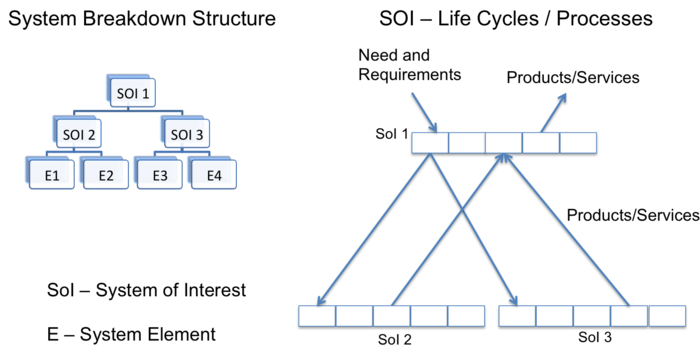Systems Lifecycle Approaches
Lead Authors: Rick Adcock, Sanford Friedenthal
In this Knowledge Area we introduce key principles of life cycle, life cycle model and life cycle processes. A generic SE paradigm is described; this forms a starting point for discussions of more detailed life cycle knowledge.
Topics
Each part of the SEBoK is divided into knowledge areas (KAs), which are groupings of information with a related theme. The KAs in turn are divided into topics. This KA contains the following topics:
See the article Matrix of Implementation Examples for a mapping of case studies and vignettes included in Part 7 to topics covered in Part 3.
Life Cycle Terminology
The term life cycle is one that engineering has borrowed from the natural sciences, it is used to describe both the changes a single organism goes through over it life and how the lives of multiple organisms interact to sustain or evolve a population. We use it in engineering in the same ways to describe the complete life of an instance of a system-of-interest (SoI); and the managed combination of multiple such instances to provide capabilities which deliver stakeholder satisfaction.
A life cycle model identifies the major stages that a specific SoI goes through, from its inception to its retirement. Life cycle models are generally implemented in development projects, and are strongly aligned with management planning and decision making.
Generic Systems Engineering Paradigm
Figure 1 identifies the overall goals of any SE effort, which are: the understanding of stakeholder value; the selection of a specific need to be addressed; the transformation of that need into a system (the product or service that provides for the need); and the use of that product or service to provide the stakeholder value. This paradigm has been developed according to the principles of the systems approach discussed in Part 2 and is used to establish a basis for the KAs in Part 3 and Part 4 of the SEBoK.
On the left side of Figure 1, there are SoI's identified in the formation of a system breakdown structure. SoI 1 is broken down into its basic elements, which in this case are systems as well (SoI 2 and SoI 3). These two systems are composed of system elements that are not refined any further.
On the right side of Figure 1, each SoI has a corresponding life cycle model (glossary) which is composed of stages that are populated with processes. The function of these processes is to define the work that is to be performed and the associated artifacts to be produced. In a model-based approach, these artifacts are captured in the system model that represent the SoI's. Note that some of the requirements defined to meet the need are distributed in the early stages of the life cycle for SoI 1, while others are designated to the life cycles of SoI 2 or SoI 3. The decomposition of the system illustrates the fundamental concept of recursion (glossary) as defined in the ISO/IEC/IEEE 15288 standard; with the standard being reapplied for each SoI (ISO 2015). It is important to point out that the requirements may be allocated to different system elements, which may be integrated in different life cycle stages of any of the three SoI's; however, together they form a cohesive system. For example, SoI 1 may be a simple vehicle composed of a chassis, motor and controls, SoI 2 an embedded hardware system, and Sol 3 a software intensive interface and control system.
When performing SE processes in stages, iteration (glossary) between stages is often required (e.g. in successive refinement of the definition of the system or in providing an update or upgrade of an existing system). The work performed in the processes and stages can be performed in a concurrent manner within the life cycle of any of the systems of interest and also among the multiple life cycles.
This paradigm provides a fundamental framework for understanding generic SE (seen in Part 3), as well as for the application of SE to the various types of systems described in Part 4.
References
Works Cited
ISO/IEC/IEEE. 2015.Systems and software engineering - system life cycle processes.Geneva, Switzerland: International Organization for Standardization (ISO)/International Electrotechnical Commission (IEC), Institute of Electrical and Electronics Engineers.ISO/IEC 15288:2015.
Primary References
INCOSE. 2015. 'Systems Engineering Handbook: A Guide for System Life Cycle Processes and Activities', version 4.0. Hoboken, NJ, USA: John Wiley and Sons, Inc, ISBN: 978-1-118-99940-0
Lawson, H. 2010. A Journey Through the Systems Landscape. London, UK: College Publications.
Additional References
None.
